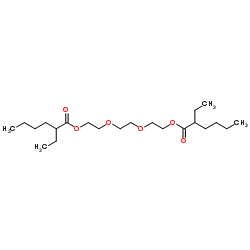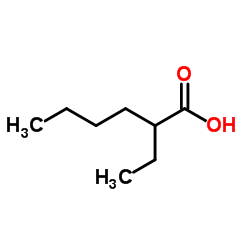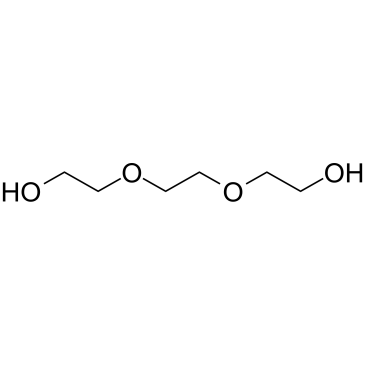94-28-0
| Name | 2-[2-[2-(2-ethylhexanoyloxy)ethoxy]ethoxy]ethyl 2-ethylhexanoate |
|---|---|
| Synonyms |
Hexanoic acid, 2-ethyl-, 1,2-ethanediylbis(oxy-2,1-ethanediyl) ester
Flexol 3GO 1,2-Ethanediylbis(oxy-2,1-ethanediyl) bis(2-ethylhexanoate) Ethane-1,2-diylbis(oxyethane-2,1-diyl) bis(2-ethylhexanoate) EINECS 202-319-2 triethylene glycol di-2-ethylhexanoate MFCD00072285 2-ethyl-hexanoic acid UNII:GE16EV367Q Flexol plasticizer 3GO |
| Density | 1.0±0.1 g/cm3 |
|---|---|
| Boiling Point | 463.5±25.0 °C at 760 mmHg |
| Melting Point | −50 °C(lit.) |
| Molecular Formula | C22H42O6 |
| Molecular Weight | 402.565 |
| Flash Point | 194.6±23.2 °C |
| Exact Mass | 402.298126 |
| PSA | 71.06000 |
| LogP | 5.57 |
| Vapour Pressure | 0.0±1.1 mmHg at 25°C |
| Index of Refraction | 1.451 |
Synonym: SECTION 2 - COMPOSITION, INFORMATION ON INGREDIENTS
Risk Phrases: None Listed. SECTION 3 - HAZARDS IDENTIFICATION EMERGENCY OVERVIEW Not available. Potential Health Effects Eye: May cause eye irritation. Skin:
May cause skin irritation. Ingestion: May cause gastrointestinal irritation with nausea, vomiting and diarrhea. Inhalation: May cause respiratory tract irritation. Chronic: Not available. SECTION 4 - FIRST AID MEASURES Eyes: Flush eyes with plenty of water for at least 15 minutes, occasionally lifting the upper and lower eyelids. Get medical aid immediately. Skin: Get medical aid. Flush skin with plenty of water for at least 15 minutes while removing contaminated clothing and shoes. Wash clothing before reuse. Ingestion: If victim is conscious and alert, give 2-4 cupfuls of milk or water. Never give anything by mouth to an unconscious person. Get medical aid immediately. Inhalation: Get medical aid immediately. Remove from exposure and move to fresh air immediately. If not breathing, give artificial respiration. If breathing is difficult, give oxygen. Notes to Physician: SECTION 5 - FIRE FIGHTING MEASURES General Information: As in any fire, wear a self-contained breathing apparatus in pressure-demand, MSHA/NIOSH (approved or equivalent), and full protective gear. During a fire, irritating and highly toxic gases may be generated by thermal decomposition or combustion. Extinguishing Media: Use agent most appropriate to extinguish fire. Use water spray, dry chemical, carbon dioxide, or appropriate foam. SECTION 6 - ACCIDENTAL RELEASE MEASURES General Information: Use proper personal protective equipment as indicated in Section 8. Spills/Leaks: Absorb spill with inert material (e.g. vermiculite, sand or earth), then place in suitable container. Clean up spills immediately, observing precautions in the Protective Equipment section. Provide ventilation. SECTION 7 - HANDLING and STORAGE Handling: Wash thoroughly after handling. Remove contaminated clothing and wash before reuse. Use only in a well-ventilated area. Avoid contact with eyes, skin, and clothing. Avoid ingestion and inhalation. Storage: Keep container closed when not in use. Store in a cool, dry, well-ventilated area away from incompatible substances. SECTION 8 - EXPOSURE CONTROLS, PERSONAL PROTECTION Engineering Controls: Use adequate ventilation to keep airborne concentrations low. Exposure Limits CAS# 94-28-0: Personal Protective Equipment Eyes: Wear appropriate protective eyeglasses or chemical safety goggles as described by OSHA's eye and face protection regulations in 29 CFR 1910.133 or European Standard EN166. Skin: Wear appropriate protective gloves to prevent skin exposure. Clothing: Wear appropriate protective clothing to prevent skin exposure. Respirators: Follow the OSHA respirator regulations found in 29 CFR 1910.134 or European Standard EN 149. Use a NIOSH/MSHA or European Standard EN 149 approved respirator if exposure limits are exceeded or if irritation or other symptoms are experienced. SECTION 9 - PHYSICAL AND CHEMICAL PROPERTIES Physical State: Liquid Color: colorless Odor: Not available. pH: Not available. Vapor Pressure: Not available. Viscosity: Not available. Boiling Point: 219 deg C @ 5.00mm Hg Freezing/Melting Point: -50 deg C Autoignition Temperature: 725 deg F ( 385.00 deg C) Flash Point: 390 deg F ( 198.89 deg C) Explosion Limits, lower: 0.46 volume % Explosion Limits, upper: Not available. Decomposition Temperature: Solubility in water: Negligible. Specific Gravity/Density: .9670g/cm3 Molecular Formula: C22H42O6 Molecular Weight: 402.57 SECTION 10 - STABILITY AND REACTIVITY Chemical Stability: Stable under normal temperatures and pressures. Conditions to Avoid: Incompatible materials, strong oxidants. Incompatibilities with Other Materials: Strong oxidizing agents. Hazardous Decomposition Products: Irritating and toxic fumes and gases. Hazardous Polymerization: Will not occur. SECTION 11 - TOXICOLOGICAL INFORMATION RTECS#: CAS# 94-28-0: MO7725000 LD50/LC50: CAS# 94-28-0: Dermal, guinea pig: LD50 = >20 mL/kg; Oral, mouse: LD50 = >3200 mg/kg; Oral, rat: LD50 = 31 gm/kg; Skin, rabbit: LD50 = 14100 uL/kg. Carcinogenicity: Triethylene glycol bis(2-ethylhexanoate) - Not listed by ACGIH, IARC, or NTP. Other: See actual entry in RTECS for complete information. SECTION 12 - ECOLOGICAL INFORMATION Ecotoxicity: Fish: Fathead Minnow: > 100 microliters/l; 96 hr. SECTION 13 - DISPOSAL CONSIDERATIONS Dispose of in a manner consistent with federal, state, and local regulations. SECTION 14 - TRANSPORT INFORMATION IATA Not regulated as a hazardous material. IMO Not regulated as a hazardous material. RID/ADR Not regulated as a hazardous material. SECTION 15 - REGULATORY INFORMATION European/International Regulations European Labeling in Accordance with EC Directives Hazard Symbols: Not available. Risk Phrases: Safety Phrases: S 24/25 Avoid contact with skin and eyes. WGK (Water Danger/Protection) CAS# 94-28-0: 1 Canada CAS# 94-28-0 is listed on Canada's DSL List. CAS# 94-28-0 is not listed on Canada's Ingredient Disclosure List. US FEDERAL TSCA CAS# 94-28-0 is listed on the TSCA inventory. SECTION 16 - ADDITIONAL INFORMATION MSDS Creation Date: 6/02/1998 Revision #3 Date: 2/04/2004 The information above is believed to be accurate and represents the best information currently available to us. However, we make no warranty of merchantability or any other warranty, express or implied, with respect to such information, and we assume no liability resulting from its use. Users should make their own investigations to determine the suitability of the information for their particular purposes. In no way shall the company be liable for any claims, losses, or damages of any third party or for lost profits or any special, indirect, incidental, consequential or exemplary damages, howsoever arising, even if the company has been advised of the possibility of such damages. SECTION 16 - ADDITIONAL INFORMATION N/A |
CHEMICAL IDENTIFICATION
HEALTH HAZARD DATAACUTE TOXICITY DATA
|
| Hazard Codes | Xn,Xi |
|---|---|
| Risk Phrases | R36/37/38:Irritating to eyes, respiratory system and skin . R22:Harmful if swallowed. |
| Safety Phrases | 24/25 |
| WGK Germany | - |
| RTECS | MO7725000 |
| HS Code | 2918990090 |
| HS Code | 2918990090 |
|---|---|
| Summary | 2918990090. other carboxylic acids with additional oxygen function and their anhydrides, halides, peroxides and peroxyacids; their halogenated, sulphonated, nitrated or nitrosated derivatives. VAT:17.0%. Tax rebate rate:13.0%. . MFN tariff:6.5%. General tariff:30.0% |


